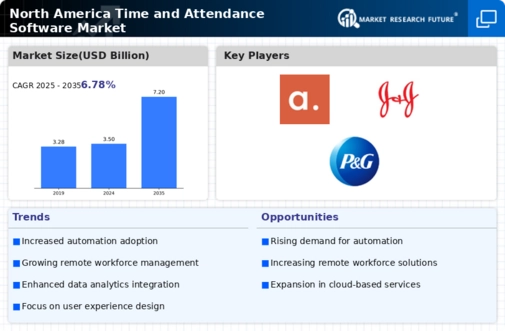Chart: Market Growth Projections
The Global North America Time and Attendance Software Market Industry is projected to experience substantial growth over the next decade. The market value is expected to reach 3.5 USD Billion in 2024, with a significant increase to 7.2 USD Billion by 2035. This growth trajectory suggests a compound annual growth rate of 6.78% from 2025 to 2035, highlighting the increasing adoption of time and attendance solutions across various sectors. The chart illustrates the anticipated market expansion, reflecting the growing importance of efficient workforce management in today's business landscape.
Regulatory Compliance and Labor Laws
The Global North America Time and Attendance Software Market Industry is significantly influenced by the evolving landscape of regulatory compliance and labor laws. Organizations are compelled to adopt time and attendance solutions to adhere to stringent regulations regarding employee hours, overtime pay, and leave management. The increasing complexity of labor laws necessitates accurate tracking and reporting, which time and attendance software can facilitate. This compliance-driven demand is expected to contribute to the market's growth, as businesses seek to mitigate risks associated with non-compliance. The anticipated market expansion to 7.2 USD Billion by 2035 underscores the critical role of these solutions in maintaining regulatory adherence.
Focus on Employee Engagement and Satisfaction
The Global North America Time and Attendance Software Market Industry is witnessing a shift towards prioritizing employee engagement and satisfaction. Organizations are increasingly aware that effective time management directly impacts employee morale and productivity. Time and attendance software facilitates flexible scheduling, self-service options, and transparent communication, fostering a positive work environment. By enhancing employee experience, companies can reduce turnover rates and improve overall performance. This focus on employee-centric solutions is likely to drive market growth, as businesses recognize the correlation between satisfied employees and organizational success. The market's expansion is indicative of this evolving workplace dynamic.
Technological Advancements in Software Solutions
Technological advancements play a pivotal role in shaping the Global North America Time and Attendance Software Market Industry. The integration of cloud computing, mobile applications, and biometric systems enhances the functionality and accessibility of time and attendance solutions. These innovations enable real-time tracking, remote access, and improved data security, appealing to a diverse range of organizations. As businesses increasingly adopt digital transformation strategies, the demand for sophisticated software solutions is likely to rise. This trend is expected to sustain a compound annual growth rate of 6.78% from 2025 to 2035, reflecting the growing reliance on technology in workforce management.
Growing Demand for Workforce Management Solutions
The Global North America Time and Attendance Software Market Industry experiences a notable surge in demand for effective workforce management solutions. Organizations increasingly recognize the importance of optimizing employee productivity and ensuring compliance with labor regulations. This trend is reflected in the projected market value of 3.5 USD Billion in 2024, indicating a robust growth trajectory. Companies are adopting time and attendance software to streamline operations, reduce payroll errors, and enhance employee satisfaction. As businesses strive for operational efficiency, the integration of advanced technologies such as artificial intelligence and machine learning into these solutions is likely to further drive market growth.














Leave a Comment